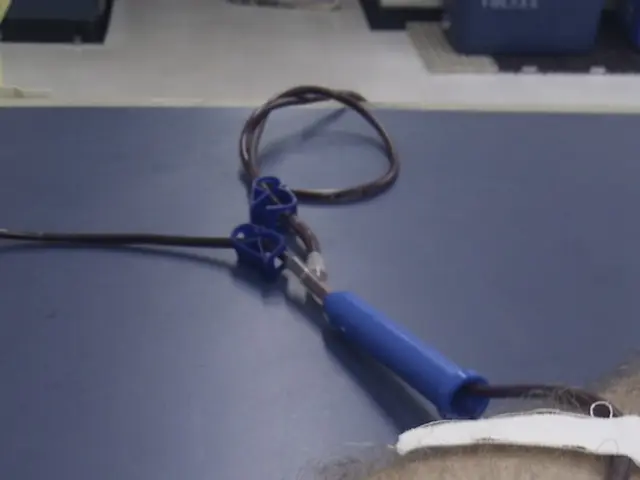Heart-Based Blood Clotting: Causes, Symptoms, and Predisposing Factors
Coronary thrombosis is a serious condition that occurs when a blood clot forms in the heart's arteries. This can lead to a heart attack, a potentially life-threatening situation.
In case of a heart attack, it's crucial to act quickly. Dial 911 or the number of the nearest emergency department immediately. If the person stops breathing before emergency services arrive, perform manual chest compressions. Lock fingers together, place the base of hands in the center of the chest, and press hard and fast, at a rate of 100 to 120 compressions per minute, to a depth of 2 inches. Continue these movements until the person starts to breathe or move.
Symptoms of coronary thrombosis include shortness of breath, chest pain, discomfort in the upper body, fainting, abnormally fast heart rate, rapid breathing, low blood pressure, sweating, and nausea. Other symptoms of a heart attack, which can be a result of coronary thrombosis, include chest pain that may spread to the arms, neck, jaw, or back, nausea and vomiting, sweaty or clammy skin, heartburn or indigestion, shortness of breath, coughing or wheezing, lightheadedness or dizziness, and anxiety that can feel similar to a panic attack.
Coronary thrombosis can be caused by damage to the endothelium, an increased tendency for blood to clot, and a decrease in blood movement within a blood vessel. There are both genetic and acquired risk factors for blood clots. Genetic risk factors include a family history of blood clots, a personal history of multiple blood clots before the age of 40 years old, and a personal history of unexplained miscarriage. Acquired risk factors include smoking, an unbalanced diet or lack of exercise leading to overweight or obesity, sitting down for too long, prolonged bed rest, pregnancy, and the use of birth control medication.
Atrial fibrillation (AFib) is a significant cause of blood clots in the heart. This irregular heartbeat disrupts normal blood flow in the atria, causing blood to pool and clots to form, raising stroke risk significantly. Heart disease, including heart failure and coronary artery disease, also increases clot risk because damaged or inefficient heart function impairs proper blood circulation. Narrowed arteries or damaged heart muscle can promote clot formation inside the heart chambers.
Inactivity or immobility, which slows blood flow, is another contributing factor. Additional systemic risk factors that favor clot formation include smoking, obesity, age (risk increases with age), pregnancy (due to venous compression and hypercoagulability), and certain medical conditions like cancer, lupus, and genetic clotting disorders that affect the blood’s tendency to clot. High estrogen states, from birth control or hormone replacement therapy, also elevate clotting risk.
The mortality rate for coronary thrombosis in the United States is significant. However, the rates of survival have risen in recent years. Doctors often prescribe blood thinners such as aspirin, clopidogrel (Plavix), prasugrel (Effient), ticagrelor (Brilinta), unfractionated heparin, and sometimes recommend surgery to remove clots.
In summary, blood clots in the heart largely arise due to impaired normal blood flow from arrhythmias such as AFib or heart muscle dysfunction, combined with systemic clotting risk factors such as immobility, inflammation, and prothrombotic states. It's essential to be aware of the risks and symptoms, and to seek immediate medical help in case of a heart attack.
- A history of unexplained miscarriage can be a genetic risk factor for blood clots.
- Apart from heart attacks, symptoms of coronary thrombosis include shortness of breath and chest pain.
- Dermatitis, a type of skin inflammation, is not directly related to coronary thrombosis, but good health-and-wellness practices can help manage overall medical-conditions including it.
- Macular degeneration, a condition affecting the eyes, is not related to coronary thrombosis, but maintaining cardiovascular-health through balanced diet, exercise, and avoiding smoking can help reduce the risk.
- Coronary thrombosis can lead to degeneration of heart muscles, which can increase clot risk.
- Type 2 diabetes, a chronic disease associated with obesity, is a systemic risk factor that favors clot formation in the heart.
- Atopic diseases, such as asthma, do not directly cause heart attacks, but controlling these conditions is important for overall health-and-wellness.
- Predictive science has played a significant role in understanding the causes and risk factors of coronary thrombosis, helping to develop more effective treatments.
- Sclerosis, a condition characterized by hardening of the arteries, is linked to a higher risk of heart attacks as it narrows the blood vessels, impeding normal blood flow.
- Crohn's disease, an inflammatory bowel condition, is not directly related to coronary thrombosis, but managing this chronic disease can contribute to overall health and reduce the risk of other health complications.




